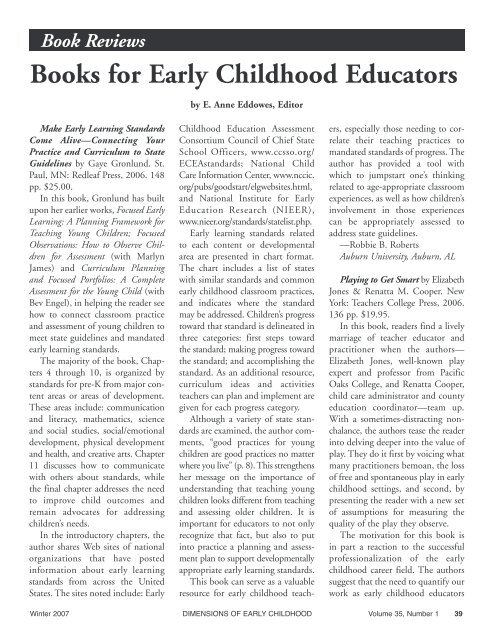Dimensions of Early Childhood - Southern Early Childhood ...
Dimensions of Early Childhood - Southern Early Childhood ...
Dimensions of Early Childhood - Southern Early Childhood ...
Create successful ePaper yourself
Turn your PDF publications into a flip-book with our unique Google optimized e-Paper software.
Book Reviews<br />
Books for <strong>Early</strong> <strong>Childhood</strong> Educators<br />
by E. Anne Eddowes, Editor<br />
Make <strong>Early</strong> Learning Standards<br />
Come Alive—Connecting Your<br />
Practice and Curriculum to State<br />
Guidelines by Gaye Gronlund. St.<br />
Paul, MN: Redleaf Press, 2006. 148<br />
pp. $25.00.<br />
In this book, Gronlund has built<br />
upon her earlier works, Focused <strong>Early</strong><br />
Learning: A Planning Framework for<br />
Teaching Young Children; Focused<br />
Observations: How to Observe Children<br />
for Assessment (with Marlyn<br />
James) and Curriculum Planning<br />
and Focused Portfolios: A Complete<br />
Assessment for the Young Child (with<br />
Bev Engel), in helping the reader see<br />
how to connect classroom practice<br />
and assessment <strong>of</strong> young children to<br />
meet state guidelines and mandated<br />
early learning standards.<br />
The majority <strong>of</strong> the book, Chapters<br />
4 through 10, is organized by<br />
standards for pre-K from major content<br />
areas or areas <strong>of</strong> development.<br />
These areas include: communication<br />
and literacy, mathematics, science<br />
and social studies, social/emotional<br />
development, physical development<br />
and health, and creative arts. Chapter<br />
11 discusses how to communicate<br />
with others about standards, while<br />
the final chapter addresses the need<br />
to improve child outcomes and<br />
remain advocates for addressing<br />
children’s needs.<br />
In the introductory chapters, the<br />
author shares Web sites <strong>of</strong> national<br />
organizations that have posted<br />
information about early learning<br />
standards from across the United<br />
States. The sites noted include: <strong>Early</strong><br />
<strong>Childhood</strong> Education Assessment<br />
Consortium Council <strong>of</strong> Chief State<br />
School Officers, www.ccsso.org/<br />
ECEAstandards; National Child<br />
Care Information Center, www.nccic.<br />
org/pubs/goodstart/elgwebsites.html,<br />
and National Institute for <strong>Early</strong><br />
Education Research (NIEER),<br />
www.nieer.org/standards/statelist.php.<br />
<strong>Early</strong> learning standards related<br />
to each content or developmental<br />
area are presented in chart format.<br />
The chart includes a list <strong>of</strong> states<br />
with similar standards and common<br />
early childhood classroom practices,<br />
and indicates where the standard<br />
may be addressed. Children’s progress<br />
toward that standard is delineated in<br />
three categories: first steps toward<br />
the standard; making progress toward<br />
the standard; and accomplishing the<br />
standard. As an additional resource,<br />
curriculum ideas and activities<br />
teachers can plan and implement are<br />
given for each progress category.<br />
Although a variety <strong>of</strong> state standards<br />
are examined, the author comments,<br />
“good practices for young<br />
children are good practices no matter<br />
where you live” (p. 8). This strengthens<br />
her message on the importance <strong>of</strong><br />
understanding that teaching young<br />
children looks different from teaching<br />
and assessing older children. It is<br />
important for educators to not only<br />
recognize that fact, but also to put<br />
into practice a planning and assessment<br />
plan to support developmentally<br />
appropriate early learning standards.<br />
This book can serve as a valuable<br />
resource for early childhood teachers,<br />
especially those needing to correlate<br />
their teaching practices to<br />
mandated standards <strong>of</strong> progress. The<br />
author has provided a tool with<br />
which to jumpstart one’s thinking<br />
related to age-appropriate classroom<br />
experiences, as well as how children’s<br />
involvement in those experiences<br />
can be appropriately assessed to<br />
address state guidelines.<br />
—Robbie B. Roberts<br />
Auburn University, Auburn, AL<br />
Playing to Get Smart by Elizabeth<br />
Jones & Renatta M. Cooper. New<br />
York: Teachers College Press, 2006.<br />
136 pp. $19.95.<br />
In this book, readers find a lively<br />
marriage <strong>of</strong> teacher educator and<br />
practitioner when the authors—<br />
Elizabeth Jones, well-known play<br />
expert and pr<strong>of</strong>essor from Pacific<br />
Oaks College, and Renatta Cooper,<br />
child care administrator and county<br />
education coordinator—team up.<br />
With a sometimes-distracting nonchalance,<br />
the authors tease the reader<br />
into delving deeper into the value <strong>of</strong><br />
play. They do it first by voicing what<br />
many practitioners bemoan, the loss<br />
<strong>of</strong> free and spontaneous play in early<br />
childhood settings, and second, by<br />
presenting the reader with a new set<br />
<strong>of</strong> assumptions for measuring the<br />
quality <strong>of</strong> the play they observe.<br />
The motivation for this book is<br />
in part a reaction to the successful<br />
pr<strong>of</strong>essionalization <strong>of</strong> the early<br />
childhood career field. The authors<br />
suggest that the need to quantify our<br />
work as early childhood educators<br />
Winter 2007 DIMENSIONS OF EARLY CHILDHOOD Volume 35, Number 1 39

















